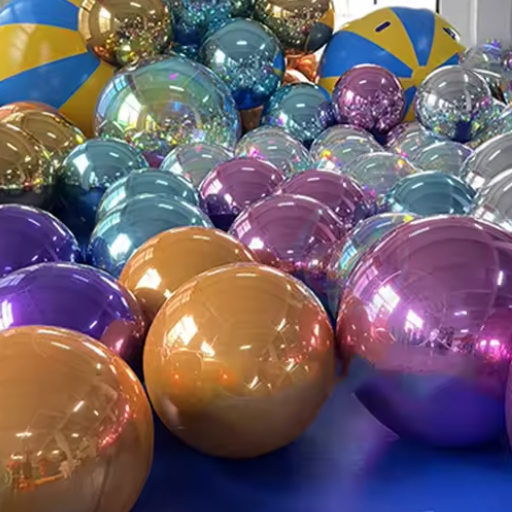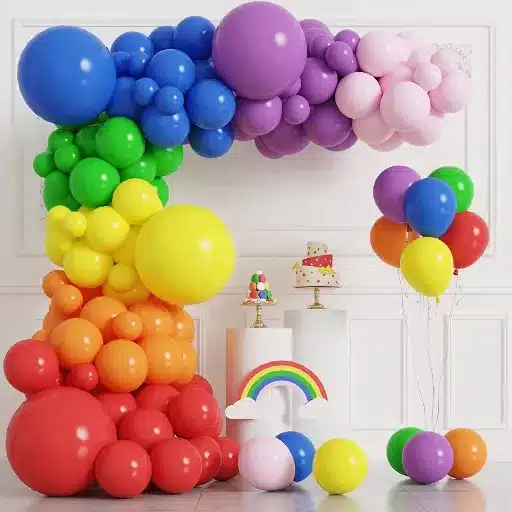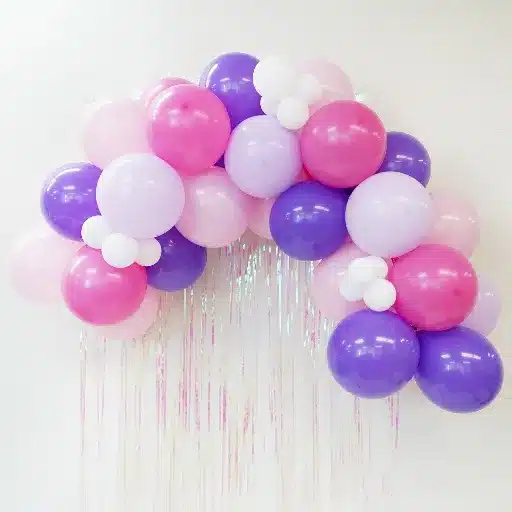Latex balloons have always been a classic choice among party decorations, adding color and fun to any event. But have you ever wondered how long they really hold up after inflation? Whether planning a birthday party, wedding, or festive occasion, understanding balloon longevity will help ensure your decorations stay vibrant throughout your event.
Balloon Longevity Overview

The lifespan of latex balloons depends on several key factors including inflation method, environmental conditions, and whether they’ve been treated with sealing agents. Understanding these factors is crucial for successful event planning.
| Balloon Type | Inflation Method | Typical Lifespan | Extended Lifespan (with Hi-Float) |
|---|---|---|---|
| Latex | Helium | 8-12 hours | 2-3 days |
| Latex | Air | Several days to weeks | N/A |
| Foil/Mylar | Helium | 3-5 days | Up to 2 weeks |
| Foil/Mylar | Air | Weeks to months | N/A |
Understanding Why Balloon Lifespan Matters
Balloon longevity significantly impacts event planning success and decoration effectiveness. Here’s why it’s important to understand:
- Event Success: Ensures decorations last throughout your entire event
- Cost Efficiency: Prevents the need for last-minute balloon replacements
- Environmental Impact: Reduces balloon waste through better planning
- Helium Conservation: Helps minimize unnecessary helium usage
Air-Filled vs. Helium-Filled Balloons

Air-Filled Latex Balloons
Air-filled balloons are gaining popularity as an environmentally friendly and cost-effective alternative to helium balloons:
- Longevity: Can last days to weeks depending on conditions
- Cost Savings: Reduce helium costs by up to 80%
- Sustainability: Don’t require scarce helium resources
- Versatility: Perfect for balloon arches, garlands, and long-term displays
Helium-Filled Balloons
While shorter-lived, helium balloons offer the advantage of floating:
- Float Time: 8-12 hours for latex, 3-5 days for foil
- Visual Impact: Create dramatic floating displays
- Event Appeal: Traditional choice for celebrations
- Enhancement Options: Can be extended with Hi-Float treatment
Environmental Factors Affecting Balloon Longevity

Several environmental conditions significantly impact how long your balloons will last:
Temperature Effects
Critical Temperature Ranges:
- Above 85°F (29°C): Latex degrades rapidly, increased pop risk
- Below 50°F (10°C): Gas contracts, balloons appear deflated
- Optimal Range: 68-72°F (20-22°C) for maximum longevity
Humidity Impact
- High Humidity: Accelerates latex degradation as material absorbs moisture
- Low Humidity: Causes latex to become brittle and prone to cracking
- Ideal Conditions: Moderate humidity levels (40-60%)
Sunlight and UV Exposure
Direct sunlight can reduce balloon lifespan by up to 50% compared to shaded conditions:
- UV radiation breaks down latex structure
- Causes discoloration and cracking
- Metallic and darker colors are most affected
- Heat absorption increases internal pressure
Wind and Physical Stress
- Strong winds cause abrasion against surfaces
- Physical wear weakens balloon material
- Can cause slow air leakage or sudden bursting
- Sheltered locations significantly extend lifespan
Material Comparison: Latex vs. Foil Balloons

| Feature | Latex Balloons | Foil/Mylar Balloons |
|---|---|---|
| Material | Natural rubber (biodegradable) | Plastic with metallic coating |
| Porosity | Porous (gas escapes quickly) | Non-porous (gas retention) |
| Helium Float Time | 8-12 hours | 3-5 days to weeks |
| Temperature Sensitivity | High (pops in heat/sun) | Low (more resistant) |
| Cost | Lower | Higher |
| Environmental Impact | Biodegradable | Not biodegradable |
| Shape Options | Flexible, many sizes | Limited shapes |
Extending Balloon Lifespan with Hi-Float

Hi-Float is a liquid coating that dramatically extends the life of helium-filled latex balloons by creating a barrier that slows helium escape.
Hi-Float Benefits
- Extended Float Time: Up to 25 times longer than untreated balloons
- Cost Effective: Reduces need for balloon replacements
- Event Planning: Allows setup 1-2 days in advance
- Reduced Waste: Fewer balloons needed overall
How to Apply Hi-Float
- Add recommended amount of Hi-Float to uninflated balloon
- Rub the outside to distribute coating evenly
- Inflate with helium as normal
- Store in cool, dry conditions for best results
Tips to Maximize Balloon Lifespan

Top 10 Longevity Tips:
- Choose high-quality latex balloons
- Use Hi-Float for helium balloons
- Avoid overinflation
- Store in temperature-controlled environments
- Keep away from direct sunlight
- Protect from sharp objects and rough surfaces
- Use appropriate balloon weights for outdoor displays
- Consider air-filled options for long-term displays
- Inflate close to event time
- Monitor and maintain throughout the event
Reference Sources
- Chaoee.com
- Article: How Long Latex Balloons Last With Regular Air
- This source discusses the longevity of air-filled latex balloons, mentioning that they can stay inflated for several days or even up to a week.
- Facebook Balloon Enthusiast Group
- Post: How many hours will balloons stay inflated without hi float
- A community-driven discussion that shares experiences about balloon durability, including air-filled balloons lasting up to 30 days in some cases.
- Quora
- Question: How long will helium balloons float outside?
- While focused on helium balloons, this source provides insights into balloon longevity, which can be compared to air-filled balloons for context.
Frequently Asked Questions
How long do balloons last in the air?
Air-filled latex balloons can remain inflated for several days to weeks, depending on storage conditions and balloon quality. Proper inflation and protection from extreme temperatures and direct sunlight will maximize their lifespan.
How long do balloons last outdoors?
Outdoor balloons have shorter lifespans due to environmental exposure. Direct sunlight can cause latex to degrade within 2-3 hours. For best results outdoors, use shaded areas and consider foil balloons for better durability.
How long will my balloons float?
Helium-filled balloons typically float for:
- Latex balloons: 8-12 hours (up to 3 days with Hi-Float)
- Foil balloons: 3-5 days (up to several weeks in ideal conditions)
How long do balloon arches last?
Balloon arch longevity depends on construction method:
- Air-filled arches: Several days to weeks
- Helium-filled arches: 8-12 hours (may require periodic replacement)
Conclusion
Understanding balloon longevity is essential for successful event planning. Whether you choose latex or foil, helium or air-filled, proper preparation and environmental considerations will ensure your decorations remain vibrant throughout your celebration. By following the guidelines in this guide, you can create stunning balloon displays that last as long as you need them to.
Remember that investing in quality balloons, using appropriate treatments like Hi-Float, and paying attention to environmental factors will give you the best results for any event, from intimate birthday parties to grand wedding celebrations.










